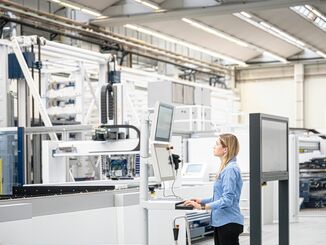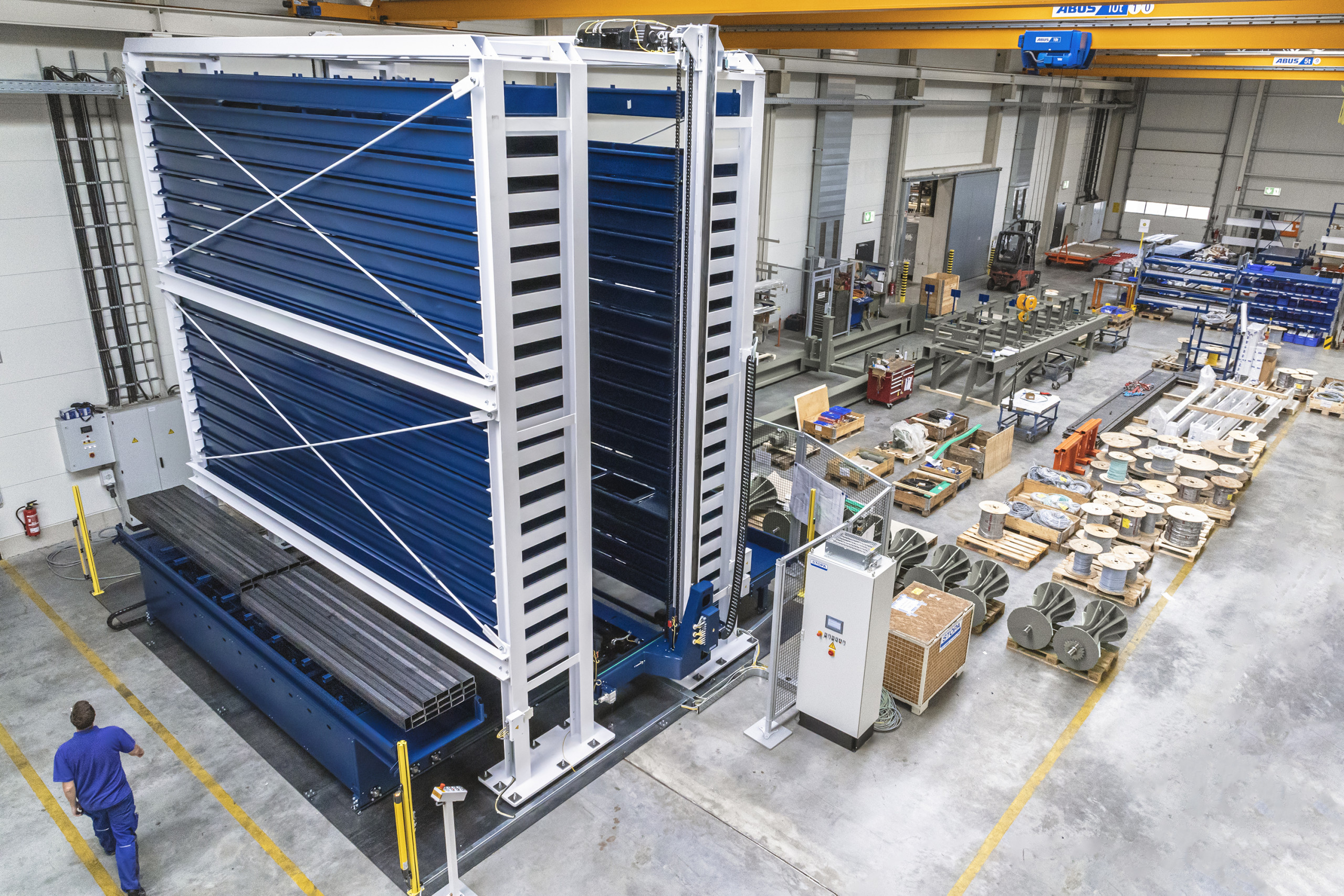
Stopa Anlagenbau GmbH designs individually tailored solutions for sheet metal and long goods storage systems so that operators use them as hubs in the material flow, for example to supply sheet metal processing machines with material.
Companies that process sheet metal are faced with increasingly complex requirements. Smaller batch sizes, stronger price pressure and factors such as a shortage of skilled workers or uncertain situations on the procurement market for materials demand a great deal of flexibility from companies in the industry. Of course, technologies such as laser cutting or various forming techniques are still evolving, but automation and digitization promise the biggest leaps. And this is particularly true of the periphery, because this is where the greatest untapped potential for many companies lies in terms of greater flexibility and productivity. This applies to all areas up to and including warehouse logistics.
One of the leaders in this field is Stopa Anlagenbau GmbH from Achern Gamshurst, manufacturer of automated storage systems for sheet metal and long goods. The company can look back on over 40 years of experience with around 2,000 systems installed worldwide. In addition, Stopa has maintained a close partnership with Trumpf for over 30 years, resulting in a perfect match between the two manufacturers’ equipment.
Apart from that, Stopa is very satisfied with the business development. In 2021, the company again achieved strong growth in order intake. However, inflation of the material can also be felt. This is noticed both by the customers and Stopa who, despite unfavorable market conditions, are surprisingly quick to notice an upswing. The annual company turnover amounts to around 70 million euros.
Against this background, Stopa presents solutions that increase the productivity and flexibility of operators and provide optimal support over the complete product life cycle. On this basis Stopa manufactures the products in a very robust design and using high quality components. In addition, customers largely receive individual solutions that can be put together from various modules.
A further advantage for the customer is that the storage systems can be dimensioned precisely to meet the respective requirements. Ultimately, customers also benefit via cost-effectiveness and efficiency. With the affordable entry for storage of flat goods, the Stopa Tower Eco MF offers beneficial additions, for example as buffer storage or for production material stocking. A space-saving system that Stopa recommends for smaller companies with a high variety of materials.
If a customer needs more flexibility due to growing storage needs and a little more flexibility, he relies on the Stopa Tower Eco Plus. A solution that can be quickly expanded by adding another storage block and additional chain conveyor or transport trolley.
If a fully automatic machine connection is required, the Stopa Tower Flex is the right choice. In addition, the manufacturer promises the Stopa Compact is a highly efficient storage system with a small footprint. Stopa Universal is also available as a system that can be measured according to requirements and automatically connected to the rest of the periphery. Apart from this, Stopa offers integration with warehouse management or ERP systems via interfaces between material supply, material flow and processing machines for the large systems. A corresponding program is also available for long goods.

© Stopa
At the show, Stopa introduced a new incoming goods table with automatic sheet alignment as a highlight. Previously, an employee had to laboriously place the sheets onto the goods receiving area using a forklift. For this purpose, there were mechanical punches, which were moved to the punches when loading the sheets. Afterwards, they had to be removed again and the material could be stored. This resulted in slight collisions with the punches, which could also cause damage to the edges of the sheet metal. A process that Stopa wanted to make more efficient, precise and fast.
At the new incoming goods table, it is possible to dispense with the punches and align the sheets fully automatically. This way, no damage can occur to either the equipment or the sheet metal. The forklift driver can now set down his sheet without having to pay close attention to the exact positioning of the panel. The system, equipped with optical sensors, automatically aligns the sheet.
Stopa has replaced the stamps with laser light barriers. After years, even such stamps would bend. If they were not replaced, the exact fit of the plates would be lost. The table is designed for large-sized sheets and has a load capacity of 3,000 kg. Stopa’s patented system moves the table on rails into the rack. The newly developed incoming goods department is a good example of how the manufacturer makes its customers’ work easier on the one hand and more efficient on the other.
The demands that will be made in the future require increasingly flexible and efficient solutions, especially in the periphery. With the use of this incoming goods table, not only damage can be avoided. Another advantage is that storage can be accelerated by around three minutes per pallet. This adds up over the course of the day and contributes to the growing productivity of the customers.
A very crucial aspect for warehouse management is the associated software. After all, the handling of material in the warehouse is only as efficient as the software with which the warehouse is operated. Stopa’s own warehouse management software (WMS) is characterized by simple operation and fast configuration options. It is available in three versions: ‘Tower System’, ‘LVS-Basic’ and ‘LVS-Extended’. Upgrade is possible at any time.
The decisive factor is ease of use. The software is the heart of the warehouse. This is set up so that the displayed overview corresponds 1:1 to the set up bearing. Every pallet is displayed there. If you click on them, you can see exactly what is stored in which place on the pallet. The operator can always display the current status.
Conversely, it is also enough to know what material is needed. If this is entered, the software shows where it is stored. Set up as a server-client system, the software can be accessed from the appropriate location in the company and any changes can be entered. Existing production machines can also be networked using the interfaces provided.
Stopa also tries to always respond to customer needs in software development. For them, intuitive operation is very important. The software is designed so that what is on a key is behind it. In addition, the company is also currently developing a new version for a long goods storage system.
Users are also increasingly focusing on the issue of service. So it’s not surprising that Stopa also sees the issue as very important. 80 percent of service cases can be solved via remote service from the manufacturer. If Stopa technicians have to be on site themselves, they come directly from their service centers distributed throughout Europe. Stopa promises different response times depending on the service package. In the Classic service package, for example, the company guarantees the arrival of a service technician within 24 hours nationally and within 48 hours Europe-wide.
Another interesting approach is Stopa’s new retrofit program. If systems exceed a certain age, it may be worthwhile to replace outdated components, such as the control system, so that it is up to date with the latest technology. Stopa does guarantee its customers to have all spare parts on site for 10 years, but after that the parts may no longer be available there. Even in such cases, the systems are retrofitted for customers so that they can continue to work reliably with the storage system. Stopa offers customers an on-site analysis with condition and risk expertise for this purpose. Thus, even older systems can be converted to promise the same performance as if they were new systems at a lower cost compared to new.
To ensure that sheet metal working companies can always manufacture with the best possible productivity, Stopa always wants to supply customers with the optimum solution. To do this, it is important to listen to them so that customer needs can be identified. In an increasingly difficult competitive environment, Stopa wants to support its customers with solutions to successfully compete.
Web:
www.stopa.com



